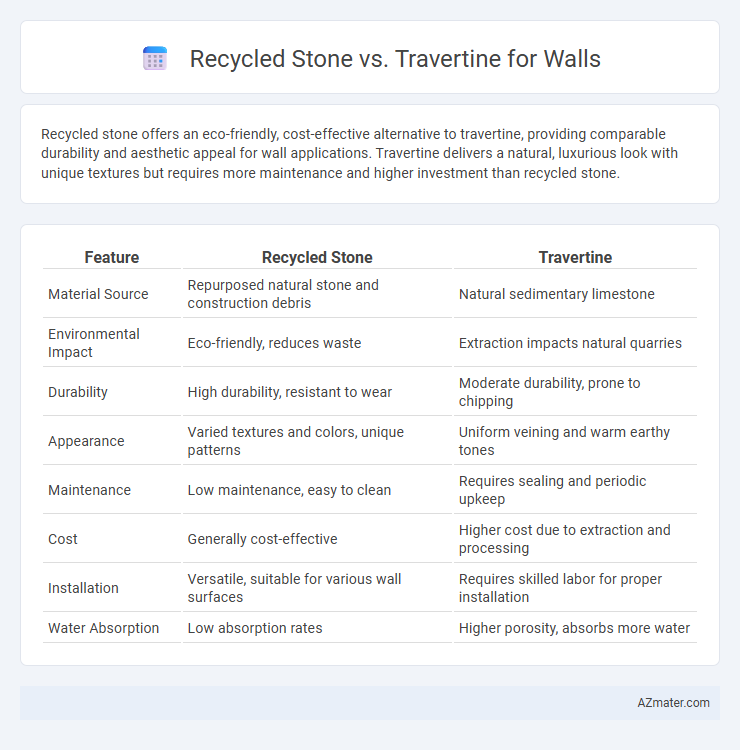Recycled stone offers an eco-friendly, cost-effective alternative to travertine, providing comparable durability and aesthetic appeal for wall applications. Travertine delivers a natural, luxurious look with unique textures but requires more maintenance and higher investment than recycled stone.
Table of Comparison
| Feature | Recycled Stone | Travertine |
|---|---|---|
| Material Source | Repurposed natural stone and construction debris | Natural sedimentary limestone |
| Environmental Impact | Eco-friendly, reduces waste | Extraction impacts natural quarries |
| Durability | High durability, resistant to wear | Moderate durability, prone to chipping |
| Appearance | Varied textures and colors, unique patterns | Uniform veining and warm earthy tones |
| Maintenance | Low maintenance, easy to clean | Requires sealing and periodic upkeep |
| Cost | Generally cost-effective | Higher cost due to extraction and processing |
| Installation | Versatile, suitable for various wall surfaces | Requires skilled labor for proper installation |
| Water Absorption | Low absorption rates | Higher porosity, absorbs more water |
Introduction to Recycled Stone and Travertine
Recycled stone is an eco-friendly material made from reclaimed natural stone fragments bonded with resin or cement, offering durability and sustainability for wall applications. Travertine, a natural limestone formed by mineral deposits from hot springs, is prized for its porous texture, warm tones, and classic aesthetic appeal in architectural designs. Both materials provide unique visual and functional qualities, with recycled stone emphasizing environmental benefits and travertine highlighting natural elegance.
Origins and Composition
Recycled stone is primarily composed of repurposed materials from demolished structures, offering an eco-friendly alternative by reducing waste while retaining various mineral compositions depending on the source stones. Travertine, a natural sedimentary rock formed from mineral deposits around hot springs, consists mainly of calcium carbonate with a distinctive porous texture and earthy tones. Understanding the origins and makeup of recycled stone and travertine helps in selecting sustainable and aesthetically appropriate options for wall applications.
Aesthetic Appeal and Design Versatility
Recycled stone offers a unique, eco-friendly aesthetic with varied textures and tones that complement rustic and contemporary wall designs, enhancing sustainability in interior and exterior spaces. Travertine stone provides timeless elegance through its smooth surface and natural veining, ideal for creating classic, luxurious, or Mediterranean-inspired walls with high design versatility. Both materials enable diverse architectural expressions, but recycled stone appeals more to environmentally conscious projects while travertine suits those prioritizing refined, polished finishes.
Durability and Longevity Comparison
Recycled stone offers high durability by utilizing crushed natural stone bound with resin or cement, making it resistant to cracking and environmental wear. Travertine, a natural limestone, provides moderate durability but is more prone to erosion and surface wear over time, especially in outdoor applications. For wall installations, recycled stone typically outperforms travertine in longevity due to its engineered composition and enhanced resistance to weathering.
Environmental Impact and Sustainability
Recycled stone offers significant environmental benefits by repurposing construction debris, reducing landfill waste, and minimizing the extraction of virgin materials compared to travertine, which requires quarrying and energy-intensive processing. Travertine's natural porosity demands chemical treatments for durability, potentially impacting ecosystems, while recycled stone's manufacturing often utilizes eco-friendly binders and processes. Choosing recycled stone supports circular economy principles and lowers carbon footprints, making it a more sustainable option for wall applications than traditional travertine.
Cost Analysis and Budget Considerations
Recycled stone offers a more cost-effective option for wall installations, often priced 30-50% lower than travertine due to its sustainable sourcing and reduced processing requirements. Travertine, while aesthetically superior with its natural veining and durability, demands a higher budget for both material and installation, often exceeding $15 to $30 per square foot. Budget considerations should weigh initial costs against long-term value, maintenance, and desired design impact when choosing between recycled stone and travertine walls.
Maintenance and Upkeep Requirements
Recycled stone walls require minimal maintenance, often needing only occasional cleaning with mild soap and water to remove dirt and moss. Travertine demands more frequent upkeep, including sealing every 1-2 years to prevent staining and erosion caused by moisture and outdoor elements. Both materials benefit from regular inspections to address cracks or chips, but recycled stone generally offers a more durable, low-maintenance option for long-term wall applications.
Installation Process and Challenges
Recycled stone offers a more eco-friendly installation process due to its lightweight composition, reducing labor intensity and structural load compared to traditional Travertine. Travertine requires careful handling to prevent chipping and often needs a specialized base and sealant to address its porous nature, increasing installation complexity and cost. Both materials demand skilled labor, but recycled stone typically presents fewer challenges related to cutting and fitting on uneven wall surfaces.
Best Applications for Each Material
Recycled stone excels in sustainable landscaping and eco-friendly wall cladding, providing unique textures and irregular shapes ideal for garden walls, retaining walls, and rustic outdoor features. Travertine offers a smooth, elegant finish perfect for indoor accent walls, bathroom surrounds, and upscale commercial spaces where durability and classic aesthetics are essential. Choosing between recycled stone and travertine depends on whether eco-conscious design or refined luxury appearance is the priority for the wall application.
Conclusion: Choosing the Right Material for Your Wall
Recycled stone offers an eco-friendly, cost-effective solution with unique textures and varied color palettes suitable for sustainable wall designs. Travertine provides timeless elegance, durability, and natural warmth, ideal for classic or luxury wall installations. Selecting between recycled stone and travertine depends on budget, environmental priorities, and the desired aesthetic impact for your space.

Infographic: Recycled stone vs Travertine for Wall
 azmater.com
azmater.com